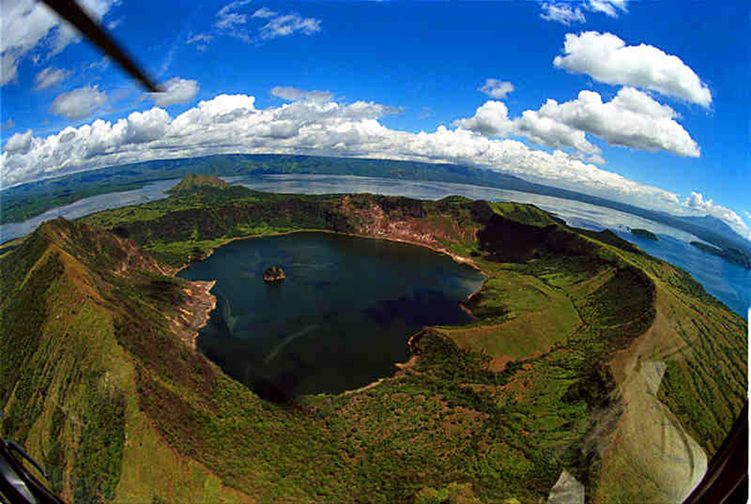
It’s More Fun in the Philippines: Taal Lake Road to entice more tourists to Batangas Province
by Leony R. Garcia
 Mention Batangas province and immediately Taal Volcano comes to mind. This is so because Taal Volcano is one of the top tourist drawers of Batangas aside from the beaches of San Juan, Calatagan, and Nasugbu. And because Batangas is just 3 to 4-hour drive from Manila, ithas the third largest tourist arrivals in the Calabarzon (Calamba-Laguna-Batangas-Rizal-Quezon) region in 2014, after Quezon and Laguna.
Mention Batangas province and immediately Taal Volcano comes to mind. This is so because Taal Volcano is one of the top tourist drawers of Batangas aside from the beaches of San Juan, Calatagan, and Nasugbu. And because Batangas is just 3 to 4-hour drive from Manila, ithas the third largest tourist arrivals in the Calabarzon (Calamba-Laguna-Batangas-Rizal-Quezon) region in 2014, after Quezon and Laguna.
The whole region last year attracted 15 million tourists, who spent an average of P1,000 a day for food, transportation, and souvenir, based on DOT estimates.
To further spur tourism in Region IV-A, the Department of Tourism (DOT) through the help of the Department of Public Works and Highways (DPWH) constructed a 4.6-kilometer Taal Lake Circumferential Road in Agoncillo which is part of a 122.9-kilometer road project for Batangas under the government’s Convergence Program on Enhancing Tourism Access.
The DOT and the DPWH officially turned over the road, worth P77 million, to the local government of Agoncillo on November 6.
 Present during the turnover ceremony were City Mayor Daniel Reyes, Agoncillo Batangas Rep. Nelso Collantes of the 3rd District of Batangas, and DOT IV-A director Rebecca Villanueva-Labit, and DPWH IV-A director Samson Hebra.
Present during the turnover ceremony were City Mayor Daniel Reyes, Agoncillo Batangas Rep. Nelso Collantes of the 3rd District of Batangas, and DOT IV-A director Rebecca Villanueva-Labit, and DPWH IV-A director Samson Hebra.
“Now, investors are taking a second look at the area, especially in Laurel, Talisay, Agoncillo, San Nicolas, Sta.Teresita, and Alitagtag,” Batangas 3rd District Representative Nelson Collantes told media representatives including the PSR. “We are going to connect the circumferential road also to Mataas Na Kahoy and Cuenca.”
Collantes initiated the Agoncillo road project under the tourism program which identifies vital access roads and other infrastructure requirements in certain tourism areas.
The Taal Lake Circumferential Road-Agoncillo Section, which currently connects the Talisay, Laurel, and Agoncillo municipalities, was completed in 2014. Completion of the entire Taal Lake Circumferential Road project is set in 2019, covering part of the Taal Volcano Protected Landscape, one of the major attractions in Batangas.
 The road is aimed to entice more tourists – local or foreign. It will also provide a faster route to these places, according to Collantes, and will cut travel time by half for the trade of agriculture and maritime products from the region.
The road is aimed to entice more tourists – local or foreign. It will also provide a faster route to these places, according to Collantes, and will cut travel time by half for the trade of agriculture and maritime products from the region.
Collantes also revealed that he is also pushing for the creation of a Taal Lake Development Authority so the lake and its tributaries would have sustainable and viable development.
With the completion of the Agoncillo Section, passengers are provided with a fast and accessible route to local tourist hot spots. It also cuts down 50 percent of the travel time of agriculture and maritime product deliveries.
This is the first official turnover under the convergence program in the region.
“The DOT-DPWH convergence is material to create accessibility to our major destinations. Taal Volcano and Lake is our iconic and major destination in the region traversed by 13 municipalities and three cities,” said DOT Region IV Director Rebecca Villanueva-Labit.
Labit said that the DOT, as chair of the Regional Eco Tourism Committee, is conducting the carrying capacity of the Taal Volcano Protected Landscape in preparation for the influx of tourists.
“Talisay, Batangas is our major entry and exit point to the volcano…with the vigor road widening, construction, and rehabilitation of the Taal Circumferential Road, which is 122 km more or less, we know that once this is finished, immediately, the opportunities not only for tourism is created,” Labit said.
The road will also promote “responsible tourism,” she said, aside from giving more income opportunities for the local communities in Batangas.
“By taking care of the natural environment and using it responsibly, we will have a more sustainable tourism, which is eco-tourism. By championing eco-tourism, we can help prevent natural disasters,” Labit said.


